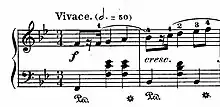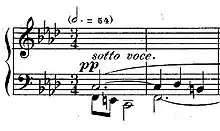Mazurkas, Op. 7 (Chopin)
The Mazurkas, Op. 7 are a set of five mazurkas by Frédéric Chopin. The mazurkas were mostly written in 1830–1831 and were published in 1832. This is the only set of Chopin's mazurkas that contains 5 pieces; all the composer's other published sets consist of either 3 or 4 mazurkas each. It is dedicated to Paul Emile Johns.
No. 1 in B-flat major

The first mazurka, set in B-flat major and marked Vivace, is the most well-known mazurka of the set and perhaps, one of Chopin's most popular mazurkas in general. The piece is in Rondo form and includes a lively main theme characterized by an upward rise and then downard jumps of ninth intervals. The second theme, in F major, is quite graceful and adds to the elegant character of the piece. After a reprise of the main theme, a third and much more subdued theme is introduced. It is quite tonally ambiguous and its mysterious mood is in total contrast with the rest of the piece. The main theme returns for a final time and the piece ends on a B-flat major chord marked forte. It takes a little under three minutes to perform.[1]
No. 2 in A minor

The second mazurka of the set, A minor is an intimate piece. Despite the Vivo, ma non troppo marking, the mazurka has a slow tempo with a very delicate and melancholy main theme. Its gentle sadness is reflective of Chopin's longing for his family and homeland, from which he was exiled around the same time as this piece's composition. This main theme is then followed by a secondary theme which is slightly tonally ambiguous and adds to the mournful quality of the piece. The middle section, in the relative key of A major, contains a slightly more uplifting melody, however it soon gives in again to the tragic main theme and the piece fades away after a final statement of this theme. It is the longest mazurka of the set and lasts for over three minutes.[2]
No. 3 in F minor

The third mazurka, in F minor, has a folkish and rustic atmosphere. After a few bars of introduction, the main theme appears, characterized by a colorful Slavic melody and sharp rhythms and accents. The second theme, A-flat major, is quite lively and includes a section with a bass motif. The main theme is reprised, this time in a slightly modfied form, and the piece ends quitely, marked pianissimo. A performance of the mazurka lasts for a little under three minutes.[3]
No. 4 in A-flat major

The fourth mazurka of the set was originally composed in 1824 when Chopin was 14 and is believed to be the first mazurka he ever wrote. It was later revised and published as part of the set. Set in A-flat major and marked Presto, ma non troppo, it features a very playful recurring main theme followed by a more lyrical episode in parallel key of F minor. The piece suddenly slows down near the end and a very short reflective theme in A major appears. However, it soon again transitions to the main theme for a final time and the mazurka ends abruptly. It is a short piece and only takes around a minute to perform.[4]
No. 5 in C major
The final mazurka is the shortest of the set, taking less than a minute to perform. It is a rare example of humour in Chopin's music. Written in the joyful key of C major and marked Vivo (meaning lively), it features a constantly repeating theme which has a jokeful character. The piece ends abruptly with the same motif of the opening bars, repetitive octaves of Gs. The ending is unusually marked Senza fine - literally without end.[5]